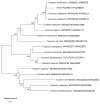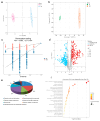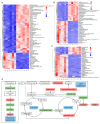First Report of Fusarium proliferatum Infection in Pods of Four-Seeded Vetch and Its Relationships with Plants
- PMID: 40431045
- PMCID: PMC12115131
- DOI: 10.3390/plants14101480
First Report of Fusarium proliferatum Infection in Pods of Four-Seeded Vetch and Its Relationships with Plants
Abstract
Vicia species are of great value in ecological restoration, soil improvement, and the development of a forage resource. In 2024, a novel pod disease affecting four-seeded vetches (Vicia tetrasperma) emerged in Rongchang District, China, leading to severe yield loss. After obtaining the main pathogenic strain, FVS1, through the tissue isolation method, which was verified according to Koch's postulates, and by combining morphological characteristics with multigene phylogenetic analysis, FVS1 was identified as Fusarium proliferatum. The biological properties indicated that the most suitable culture medium of the fungus was oatmeal agar (OA), with the optimum growth temperature 25 °C and the lethal temperature being 35 °C. FVS1 exhibited insensitivity within a pH range of 7 to 9, as well as high adaptability to variations in light duration. To elucidate the physiological and biochemical changes in four-seeded vetches in response to FVS1 infection, non-targeted metabolomics analysis identified 379 differential metabolites, mainly comprising organic acids and derivatives, lipids and lipid-like molecules, and phenylpropanoids and polyketides. The results demonstrated that F. proliferatum primarily induced the disease by influencing alterations in the secondary metabolites associated with amino acid metabolism, lipid metabolism, and flavonoid biosynthesis. Four-seeded vetches improved tolerance to the fungus by accumulating histidine, aspartic acid, arginosuccinate, ethanolamine, glycerophosphocholine, naringenin, and catechin. Trichoderma harzianum (M3) had the best control effectiveness, and the inhibition rate was 60.68%. This study, for the first time, revealed that F. proliferatum caused a pod disease in four-seeded vetches. We analyzed the mechanism of plant-pathogen interaction and screened potential biocontrol strains, providing a theoretical basis for regional disease management.
Keywords: Fusarium proliferatum; Vicia tetrasperma; biological characteristics; biological control; metabolomics analysis.
Conflict of interest statement
The authors declare no conflicts of interest.
Figures









Similar articles
-
Signs and symptoms to determine if a patient presenting in primary care or hospital outpatient settings has COVID-19.Cochrane Database Syst Rev. 2022 May 20;5(5):CD013665. doi: 10.1002/14651858.CD013665.pub3. Cochrane Database Syst Rev. 2022. PMID: 35593186 Free PMC article.
-
Citric acid impairs type B trichothecene biosynthesis of Fusarium graminearum but enhances its growth and pigment biosynthesis: transcriptomic and proteomic analyses.Appl Environ Microbiol. 2025 Jun 18;91(6):e0153124. doi: 10.1128/aem.01531-24. Epub 2025 May 14. Appl Environ Microbiol. 2025. PMID: 40366181 Free PMC article.
-
Phylogenetic analysis of plant-pathogenic and non-pathogenic Trichoderma isolates on maize from plants, soil, and commercial bio-products.Appl Environ Microbiol. 2025 Mar 19;91(3):e0193124. doi: 10.1128/aem.01931-24. Epub 2025 Feb 27. Appl Environ Microbiol. 2025. PMID: 40013788 Free PMC article.
-
Fungal Pathogens Associated with Crown and Root Rot in Wheat-Growing Areas of Northern Kyrgyzstan.J Fungi (Basel). 2023 Jan 16;9(1):124. doi: 10.3390/jof9010124. J Fungi (Basel). 2023. PMID: 36675945 Free PMC article.
-
Systemic pharmacological treatments for chronic plaque psoriasis: a network meta-analysis.Cochrane Database Syst Rev. 2021 Apr 19;4(4):CD011535. doi: 10.1002/14651858.CD011535.pub4. Cochrane Database Syst Rev. 2021. Update in: Cochrane Database Syst Rev. 2022 May 23;5:CD011535. doi: 10.1002/14651858.CD011535.pub5. PMID: 33871055 Free PMC article. Updated.
References
-
- Costa M.M., Sandoval-Denis M., Moreira G.M., Kandemir H., Kermode A., Buddie A.G., Ryan M.J., Becker Y., Yurkov A., Maier W., et al. Known from Trees and the Tropics: New Insights into the Fusarium lateritium Species Complex. Stud. Mycol. 2024;109:403–450. doi: 10.3114/sim.2024.109.06. - DOI - PMC - PubMed
-
- Conti Taguali S., Riolo M., Dopazo V., Meca G., Cacciola S.O. Characterization of Mycotoxins Produced by Two Fusarium Species Responsible for Postharvest Rot of Banana Fruit. J. Plant Pathol. 2024;106:1785–1800. doi: 10.1007/s42161-024-01751-8. - DOI
-
- Ćeranić A., Svoboda T., Berthiller F., Sulyok M., Samson J.M., Güldener U., Schuhmacher R., Adam G. Identification and Functional Characterization of the Gene Cluster Responsible for Fusaproliferin Biosynthesis in Fusarium proliferatum. Toxins. 2021;13:468. doi: 10.3390/toxins13070468. - DOI - PMC - PubMed
-
- Xie S.H., Zhang C., Chen M.S., Wei Z.P., Jiang Y.B., Lin X., Zheng Y.Q. Fusarium proliferatum: A New Pathogen Causing Fruit Rot of Peach in Ningde, China. Plant Dis. 2018;102:1858. doi: 10.1094/PDIS-01-18-0103-PDN. - DOI
Grants and funding
LinkOut - more resources
Full Text Sources

